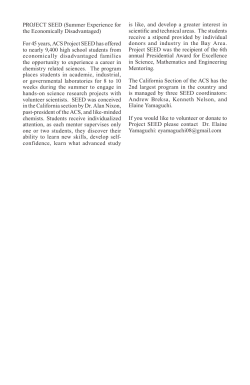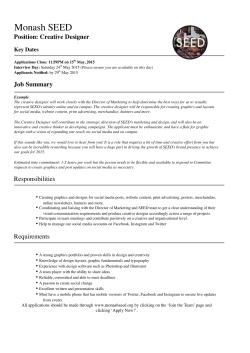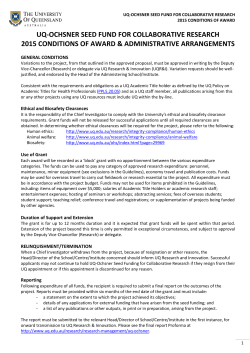
å¦ ä½ è« æ è¦ æ¨ Study on the Lotus (Nelumbo nucifera Gaertn
学位論文要旨 Study on the Lotus (Nelumbo nucifera Gaertn.) Seed Proteome ハス種子のプロテオームに関する研究 応用生命科学専攻 生物機能化学大講座 Carlo Frederico Moro Nelumbo nucifera, commonly known as the lotus, is a taxonomically unique aquatic plant native to India, but that has been widely spread through Asia and the Middle East since ancient times. It is presently cultivated and consumed as food, mainly in China and Japan. In addition to its use as food, the lotus plant is also widely used in Indian and Chinese traditional medicine. Extracts from different parts of the lotus plant have been reported to show several biological activities, such as antioxidant, free radical scavenging, anti-inflammatory, and immunomodulatory activities, among others. Despite this, little work has been done in isolating and identifying proteins responsible for these activities, or to establish a lotus plant proteome. The aim of this work is to develop a proteome catalog of the lotus plant, starting with its seed, which has a large nutrient content and is known for its extreme durability. Three tissues of the lotus seed, differing in the basis of location and/or development stage, were analyzed with aims to the establishment of their proteome: the mature seed endosperm, the mature seed embryo, and the immature seed endosperm. Initially, techniques for protein extraction based on the uses of different extraction buffers (TBS, LB-TT, TCA-acetone and phenol) were tested to determine the most suitable extraction procedure in terms of extracted protein content, yield and purity. A protocol to reduce the abundance of seed storage proteins and increase the relative abundance of functional proteins by precipitation with protamine sulfate was also tested. In order to obtain the proteomic inventories from these protein extracts, parallel complementary analytic approaches were used: N-terminal amino acid sequencing of protein bands, as well as one- and two-dimensional gel electrophoresis coupled with mass spectrometry (ESI-MS/MS and LC-MS/MS). For the N-terminal sequencing analysis, proteins were separated in bands by 1-D SDS-PAGE, using different acrylamide concentrations for better separation across different molecular weight ranges. Bands were blotted into PVDF membranes, 19 of which were excised and analyzed by N-terminal amino acid sequencing via Edman degradation. Resulting peptide sequences were not optimal, but analysis via BLAST search was able to generate a short list of 7 likely proteins, out of 16 potential matches, present in the mature endosperm, such as nutrient storage proteins. In the first mass spectrometry approach, also called bottom-up proteomics, or “shotgun” proteomics, proteins were separated in 1-D SDS-PAGE, divided into fractions referent to horizontal slices of the 1-D gel, then subjected to in-gel trypsin digestion, extracted and analyzed by mass spectrometry, generating a large list of identified peptide sequences for each fraction, which were then compared against protein databases, to generate list of possible matches. From this technique, 66 likely protein matches were found for the mature endosperm, 141 for the embryo, and 117 for the immature endosperm. In the second, “top-down” approach, proteins were separated by isoelectric point and molecular weight in 2-D PAGE. By this technique, 41 likely protein matches were identified for the endosperm, 32 for the embryo, and 41 for the immature endosperm. Individual protein spots selected from these gels were then excised, digested with trypsin, extracted and analyzed by mass spectrometry. The peptides identified in these spots were also compared against protein databases to generate a most likely match or matches to the protein present for each individual spot. In both cases, the protein matches found in the databases considered most likely to represent protein equivalency were catalogued. The mass spectrometry approaches were performed for the three seed tissues studied. Gene ontology data for these identified proteins was compiled and analyzed with aims to quantify the differences in metabolic functionality of the proteins present in the different tissues. From the number of protein matches found related to different metabolic functions, it was possible to determine a prevalence of proteins related to carbohydrate metabolism in both the mature and immature endosperm, with a relatively high presence of starch synthases in the immature endosperm, as well as indication of seed storage proteins in the mature endosperm. In the case of the embryo, amino acid and protein metabolism, as well as translational processes seemed to be more prevalent. Several individual proteins that had been of particular interest due to their role in the seed metabolism and potential either in health/nutritional role, or as possible targets for cloning and recombinant expression, were also searched for and identified in the obtained proteomes. Moreover the few proteins that had been previously described in the lotus at genome and transcriptome, such as the cytosolic class II small heat shock proteins NnHSP17.5 and the cytosolic copper-zinc superoxide dismutases cytCuZnSOD, or in one case, the NnANN1 annexin, at proteome level, were confidently identified in the lotus seed proteome, all of those being related to heat response and antioxidant activity. From the results of the lotus seed proteome in general, a large number of proteins related to stress response, particularly heat stress, were to be found in the seed, something that is most likely linked to the plant’s exceptional tolerance to stress, seed durability and germinating vigor. The proteins related to energy metabolism found across the proteome could also fill a great part of the positions in the putative glycolysis, citric acid cycle and starch metabolism pathways.
© Copyright 2025










